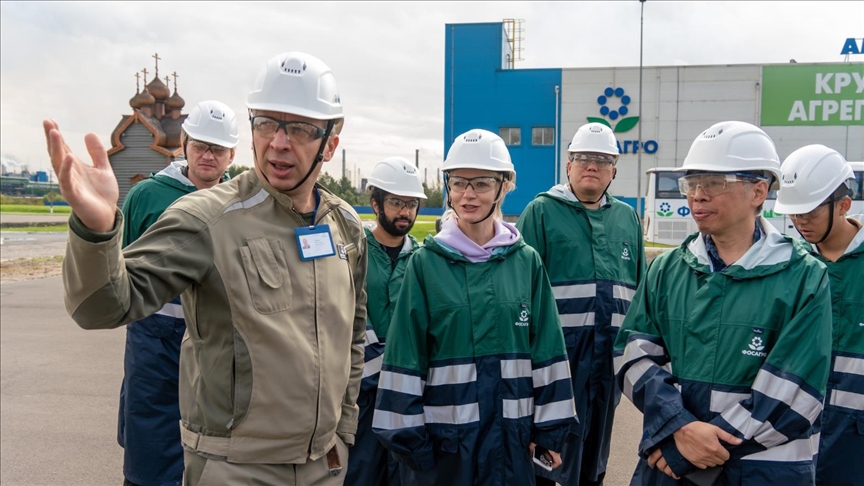
- Russia produced almost 60M tons of fertilizers last year, after becoming the world's largest exporter of the product in 2022 with $18.7B across the world
- Fertilizer production is a vital industry that serves as 'an example of what chemistry benefits for all mankind,' Svetlana Zlobina, head of an educational center by Russian company PhosAgro
MOSCOW
Fertilizer is a crucial agricultural input to feeding the world’s population, and Russia is one of its world’s largest producers of its mineral variety.
According to figures from the Russian Federal State Statistics Service, the country exported $18.7 billion worth of fertilizers in 2022, making it the world's largest exporter that year. Top destinations of the Russian fertilizers include Brazil ($5.31 billion), India ($2.73 billion), the US ($1.95 billion), China ($910 million), and Indonesia ($699 million).
In 2021-2022, exports to India saw a remarkable increase of over six-fold. In the first seven months of this year, Russia further boosted its output by 13%, according to the Russian news agency TASS.
Vladimir Karpov, head of PhosAgro's company production service, explained to Anadolu that Russian fertilizers are produced from an ore, known as apatite-nepheline, extracted from the Khibiny Mountains, a range located on the Kola Peninsula near Russia’s border with Finland. This volcanic rock is rich in phosphorus and free of harmful impurities, ensuring high-quality and environmentally safe fertilizers.
“At a specially designed factory, the ore is separated into apatite and nepheline concentrates,” Karpov shared. “The apatite concentrate, in powdered form, is then sent to further processing. It interacts with other ingredients to produce the necessary type of phosphorus fertilizers.”
According to Karpov, Phosagro company has three production sites across Russia — in the cities of Cherepovets, Volkhov, and Balakovo, each of the mentioned sites has its own special feature.
“Cherepovets produces 52 brands of fertilizers, including liquid fertilizers that can be applied to the soil without diluting with water. Among the products of the enterprise in Volkhov are not only phosphorus-containing fertilizers, but also fertilizers based on potassium and sodium. In addition to fertilizers, feed additives for animals are produced in Balakovo,” Karpov said.
Russia's journey to fertilizer production leadership
Svetlana Zlobina, head of PhosAgro’s interactive educational center Green Planet, traced the history of Russia’s fertilizer industry. It began in the 19th century with the ideas of German scientist Justus von Liebig and was put into practice at the first agricultural school in Cherepovets.

Svetlana Zlobina, head of PhosAgro’s interactive educational center Green Planet
“Agronomists did not just talk about benefits of fertilizers, they showed it in practice — an experimental field was divided into several parts and sown, scientists used a different kind of fertilizer on each site. One plot was left as a control. The greatest harvest was obtained on the plot where complex fertilizers, containing nitrogen, phosphorus and potassium were applied, all the minerals necessary for plants,” explained Zlobina.

The industry saw significant growth after the Russian revolution of 1917 and World War II, with the construction of major plants like the Cherepovets nitrogen-tuck plant in 1969 and the Cherepovets Ammophos Plant in 1974.
The Cherepovets Complex PhosAgro, a successor of that plant, is one of the world’s main producers of this type of fertilizer, Zlobina said.
“Cherepovets was chosen as the place for the plant’s construction for its strong transport infrastructure, skilled labor, and access to coke and chemical production from the local metallurgical industry.
“And coke oven gas is an important part for ammonia production. The very first products that were created were ammonia and ammonium nitrate,” she explained, adding that as fertilizer production prospered, the facility’s production was expanded to include phosphorus fertilizers, as well.
Current production and global reach
In 2023, Russia produced almost 60 million tons of fertilizers, with PhosAgro contributing 11 million tons. PhosAgro’s products reach 100 countries, though Russia remains the company's top priority market.
“Fertilizer production is a responsible business in every sense. It is impossible to do something for the benefit of humanity and at the same time not meet the highest humanitarian standards and values,” says Zlobina.

She asserts that despite the complex and potentially hazardous production process of fertilizer, involving substances like sulfuric acid, nitric acid, and ammonia, the end result serves a vital purpose.
"Fertilizer production is a vital industry and a complex chemical process that involves, among other things, dangerous substances — sulfuric, phosphoric, nitric acids. Ultimately, they help to obtain useful fertilizers – fertility vitamins, which means they serve as an example of what chemistry benefits for all mankind."








